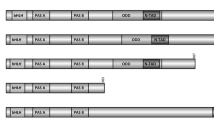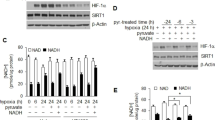Abstract
Hypoxia-inducible factors (HIFs) are key mediators expressed under hypoxic condition and involved in many kinds of disease such as cancer and abnormal angiogenesis. Thus, development of their inhibitor has been extensively explored. Here, we describe a finding that Remodelin, a specific inhibitor of NAT10, could also inhibit the expression of HIFs. The presence of Remodelin could suppress the elevated level of HIF-1α protein and its nuclear translocation induced by either treatment of cobalt chloride (CoCl2) or hypoxia in dose or time-dependent way. More importantly, Remodelin could also inhibit the constitutional expression of HIF-1α and HIF-2α in VHL mutant 786-0 cells. With using of cells with depletion of NAT10 by shRNA or Crispr-Cas9 edited, we further demonstrated that inhibition of HIFs by Remodelin should need NAT10 activity. In biological analysis, the treatment of cultured HUVECs with Remodelin could inhibit in vitro cell migration and invasion and tube-formation. Our investigation implied that Remodelin could be a new potential inhibitor of HIFs for using in angiogenesis targeting therapy in either cancers or inflammatory diseases.







Similar content being viewed by others
Change history
07 July 2020
The article “Remodelin, an inhibitor of NAT10, could suppress hypoxia-induced or constitutional expression of HIFs in cells”, written by “Yaqian Wu, Yanan Cao, Haijing Liu, Mengfei Yao, Ningning Ma and Bo Zhang”, was originally published electronically on the publisher's internet portal https://link.springer.com/article/10.1007/s11010-020-03776-w on 11 June 2020 with open access. With the author(s)' decision to step back from Open Choice, the copyright of the article changed on 6 July 2020 to © Springer Science+Business Media, LLC, part of Springer Nature 2020 and the article is forthwith distributed under the terms of copyright. The original article has been corrected.
References
Semenza GL (2012) Hypoxia-inducible factors in physiology and medicine. Cell 148(3):399–408. https://doi.org/10.1016/j.cell.2012.01.021
Wu D, Potluri N, Lu J, Kim Y, Rastinejad F (2015) Structural integration in hypoxia-inducible factors. Nature 524(7565):303–308. https://doi.org/10.1038/nature14883
Swartz JE, Pothen AJ, Stegeman I, Willems SM, Grolman W (2015) Clinical implications of hypoxia biomarker expression in head and neck squamous cell carcinoma: a systematic review. Cancer Med 4(7):1101–1116. https://doi.org/10.1002/cam4.460
Kaelin WG Jr, Ratcliffe PJ (2008) Oxygen sensing by metazoans: the central role of the HIF hydroxylase pathway. Mol Cell 30(4):393–402. https://doi.org/10.1016/j.molcel.2008.04.009
Prager GW, Poettler M (2012) Angiogenesis in cancer. Basic mechanisms and therapeutic advances. Hamostaseologie 32(2):105–114. https://doi.org/10.5482/ha-1163
Duan W, Chang Y, Li R, Xu Q, Lei J, Yin C, Li T, Wu Y, Ma Q, Li X (2014) Curcumin inhibits hypoxia inducible factor1alphainduced epithelialmesenchymal transition in HepG2 hepatocellular carcinoma cells. Mol Med Rep 10(5):2505–2510. https://doi.org/10.3892/mmr.2014.2551
Wang GL, Jiang BH, Rue EA, Semenza GL (1995) Hypoxia-inducible factor 1 is a basic-helix-loop-helix-PAS heterodimer regulated by cellular O2 tension. Proc Natl Acad Sci USA 92(12):5510–5514. https://doi.org/10.1073/pnas.92.12.5510
Zhang H, Hou W, Wang HL, Liu HJ, Jia XY, Zheng XZ, Zou YX, Li X, Hou L, McNutt MA, Zhang B (2014) GSK-3beta-regulated N-acetyltransferase 10 is involved in colorectal cancer invasion. Clin Cancer Res 20(17):4717–4729. https://doi.org/10.1158/1078-0432.Ccr-13-3477
Lv J, Liu H, Wang Q, Tang Z, Hou L, Zhang B (2003) Molecular cloning of a novel human gene encoding histone acetyltransferase-like protein involved in transcriptional activation of hTERT. Biochem Biophys Res Commun 311(2):506–513. https://doi.org/10.1016/j.bbrc.2003.09.235
Shen Q, Zheng X, McNutt MA, Guang L, Sun Y, Wang J, Gong Y, Hou L, Zhang B (2009) NAT10, a nucleolar protein, localizes to the midbody and regulates cytokinesis and acetylation of microtubules. Exp Cell Res 315(10):1653–1667. https://doi.org/10.1016/j.yexcr.2009.03.007
Chi YH, Haller K, Peloponese JM Jr, Jeang KT (2007) Histone acetyltransferase hALP and nuclear membrane protein hsSUN1 function in de-condensation of mitotic chromosomes. J Biol Chem 282(37):27447–27458. https://doi.org/10.1074/jbc.M703098200
Larrieu D, Britton S, Demir M, Rodriguez R, Jackson SP (2014) Chemical inhibition of NAT10 corrects defects of laminopathic cells. Science 344(6183):527–532. https://doi.org/10.1126/science.1252651
Balmus G, Larrieu D, Barros AC, Collins C, Abrudan M, Demir M, Geisler NJ, Lelliott CJ, White JK, Karp NA, Atkinson J, Kirton A, Jacobsen M, Clift D, Rodriguez R, Adams DJ, Jackson SP (2018) Targeting of NAT10 enhances healthspan in a mouse model of human accelerated aging syndrome. Nat Commun 9(1):1700. https://doi.org/10.1038/s41467-018-03770-3
Oh TI, Lee YM, Lim BO, Lim JH (2017) Inhibition of NAT10 suppresses melanogenesis and melanoma growth by attenuating microphthalmia-associated transcription factor (MITF) expression. Int J Mol Sci 18(9):1924. https://doi.org/10.3390/ijms18091924
Zhang X, Chen J, Jiang S, He S, Bai Y, Zhu L, Ma R, Liang X (2019) N-acetyltransferase 10 enhances doxorubicin resistance in human hepatocellular carcinoma cell lines by promoting the epithelial-to-mesenchymal transition. Oxid Med Cell Longev 2019:7561879. https://doi.org/10.1155/2019/7561879
Xiang X, Li C, Chen X, Dou H, Li Y, Zhang X, Luo Y (2019) CRISPR/Cas9-mediated gene tagging: a step-by-step protocol. Methods Mol Biol 1961:255–269. https://doi.org/10.1007/978-1-4939-9170-9_16
Prakash P, Lantz TC, Jethava KP, Chopra G (2019) Rapid, refined, and robust method for expression, purification, and characterization of recombinant human amyloid beta 1–42. Methods Protoc 2(2):48. https://doi.org/10.3390/mps2020048
Liu H, Ling Y, Gong Y, Sun Y, Hou L, Zhang B (2007) DNA damage induces N-acetyltransferase NAT10 gene expression through transcriptional activation. Mol Cell Biochem 300(1–2):249–258. https://doi.org/10.1007/s11010-006-9390-5
Maxwell PH, Wiesener MS, Chang GW, Clifford SC, Vaux EC, Cockman ME, Wykoff CC, Pugh CW, Maher ER, Ratcliffe PJ (1999) The tumour suppressor protein VHL targets hypoxia-inducible factors for oxygen-dependent proteolysis. Nature 399(6733):271–275. https://doi.org/10.1038/20459
Xia M, Bi K, Huang R, Cho MH, Sakamuru S, Miller SC, Li H, Sun Y, Printen J, Austin CP, Inglese J (2009) Identification of small molecule compounds that inhibit the HIF-1 signaling pathway. Mol Cancer 8:117. https://doi.org/10.1186/1476-4598-8-117
Parker R, Sheth U (2007) P bodies and the control of mRNA translation and degradation. Mol Cell 25(5):635–646. https://doi.org/10.1016/j.molcel.2007.02.011
Luo Y, Na Z, Slavoff SA (2018) P-bodies: composition, properties, and functions. Biochemistry 57(17):2424–2431. https://doi.org/10.1021/acs.biochem.7b01162
Fillman C, Lykke-Andersen J (2005) RNA decapping inside and outside of processing bodies. Curr Opin Cell Biol 17(3):326–331. https://doi.org/10.1016/j.ceb.2005.04.002
Anderson P, Kedersha N, Ivanov P (2015) Stress granules, P-bodies and cancer. Biochim Biophys Acta 1849(7):861–870. https://doi.org/10.1016/j.bbagrm.2014.11.009
Yuan Y, Hilliard G, Ferguson T, Millhorn DE (2003) Cobalt inhibits the interaction between hypoxia-inducible factor-alpha and von Hippel-Lindau protein by direct binding to hypoxia-inducible factor-alpha. J Biol Chem 278(18):15911–15916. https://doi.org/10.1074/jbc.M300463200
Ito S, Horikawa S, Suzuki T, Kawauchi H, Tanaka Y, Suzuki T, Suzuki T (2014) Human NAT10 is an ATP-dependent RNA acetyltransferase responsible for N4-acetylcytidine formation in 18 S ribosomal RNA (rRNA). J Biol Chem 289(52):35724–35730. https://doi.org/10.1074/jbc.C114.602698
Sharma S, Langhendries JL, Watzinger P, Kotter P, Entian KD, Lafontaine DL (2015) Yeast Kre33 and human NAT10 are conserved 18S rRNA cytosine acetyltransferases that modify tRNAs assisted by the adaptor Tan1/THUMPD1. Nucleic Acids Res 43(4):2242–2258. https://doi.org/10.1093/nar/gkv075
Arango D, Sturgill D, Alhusaini N, Dillman AA, Sweet TJ, Hanson G, Hosogane M, Sinclair WR, Nanan KK, Mandler MD, Fox SD, Zengeya TT, Andresson T, Meier JL, Coller J, Oberdoerffer S (2018) Acetylation of cytidine in mRNA promotes translation efficiency. Cell 175(7):1872–1886.e1824. https://doi.org/10.1016/j.cell.2018.10.030
Escuin D, Kline ER, Giannakakou P (2005) Both microtubule-stabilizing and microtubule-destabilizing drugs inhibit hypoxia-inducible factor-1alpha accumulation and activity by disrupting microtubule function. Cancer Res 65(19):9021–9028. https://doi.org/10.1158/0008-5472.Can-04-4095
Carbonaro M, O'Brate A, Giannakakou P (2011) Microtubule disruption targets HIF-1alpha mRNA to cytoplasmic P-bodies for translational repression. J Cell Biol 192(1):83–99. https://doi.org/10.1083/jcb.201004145
Acknowledgements
This article is distributed under the terms of the Creative Commons Attribution Noncommercial License which permits any noncommercial use, distribution, and reproduction in any medium, provided the original author(s) and source are credited. This project was supported by Chinese National Natural Science Foundation (Grant Nos. 81872018, 81372292), and Key project from the Chinese Ministry of Science and Technology (Grant Nos. 2013YQ03065108, 2017YFC0110200).
Author information
Authors and Affiliations
Corresponding author
Ethics declarations
Conflicts of interest
All authors declare that they have no competing interests.
Additional information
Publisher's Note
Springer Nature remains neutral with regard to jurisdictional claims in published maps and institutional affiliations.
The original version of this article was revised due to a retrospective Open Access cancellation
Rights and permissions
About this article
Cite this article
Wu, Y., Cao, Y., Liu, H. et al. Remodelin, an inhibitor of NAT10, could suppress hypoxia-induced or constitutional expression of HIFs in cells. Mol Cell Biochem 472, 19–31 (2020). https://doi.org/10.1007/s11010-020-03776-w
Received:
Accepted:
Published:
Issue Date:
DOI: https://doi.org/10.1007/s11010-020-03776-w




